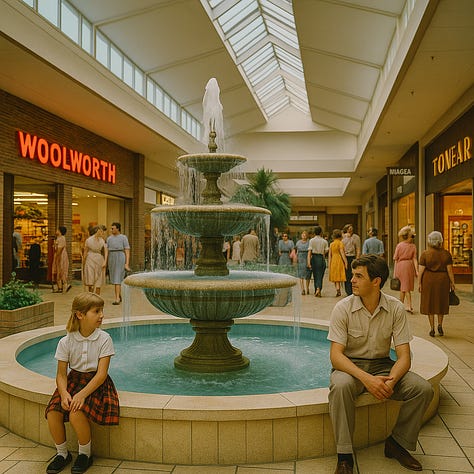🏷️ The Mall Fountain: When Shopping Became a Destination
You didn’t just shop. You went to the mall.
There was a time when “going to the mall” wasn’t about buying.
It was about being.
👟 Meeting friends.
🍕 Grabbing a slice.
💧 Dropping a coin in the fountain and making a wish.
🛍️ Maybe you bought something. But that was never the whole point.
Where did this start?



The American shopping mall - modern, enclosed, and climate-controlled—emerged in the 1950s, a time when suburbia was expanding and car culture redefined access.
At the center of this shift was architect Victor Gruen, an Austrian émigré who designed the first enclosed mall: Southdale Center in Edina, Minnesota, in 1956.
But Gruen’s vision wasn’t just commercial. It was civic.
He wanted malls to feel like town squares:
With natural light, even in winter.
With courtyards and fountains, where people could linger.
With seating, cafés, and gardens—spaces designed for being, not just buying.
💡 He called it “a community center with a roof.”
And it worked.
By the 1970s and ‘80s, malls had become America’s third place—after home and work.
Teens “hung out” in food courts.
Kids threw pennies into wishing fountains.
Holidays were marked by mall Santas, seasonal displays, and window shopping traditions.
And here’s the key: this wasn’t aesthetic indulgence.
It was strategic retail psychology.
Why did it work?
Fountains slowed traffic flow - encouraging people to linger and discover stores they hadn’t planned to visit.
Natural light from skylights and atriums increased time spent indoors - especially in colder regions.
Comfortable gathering spaces created emotional memory, not just transactions.
📈 Studies in the 1980s found that the longer people stayed in a mall, the more they spent—even if they hadn’t planned to.
In other words:
Design created dwell time. Dwell time created dollars.
What’s the Echo today?
Modern commerce chases convenience—but experience still drives connection.
Apple stores use open space, touch, and conversation zones to elevate tech into lifestyle.
Retailers like Glossier and Nike build experiential flagships that invite play, not just purchase.
Online platforms now use visual design, scroll speed, and “ambient branding” to replicate the mall’s atmospheric cues.
💡 But maybe the most powerful echo?
Nostalgia.
The smell of Auntie Anne’s.
The sound of a central fountain.
The soft echo of footsteps on terrazzo floors.
People don’t just shop where it’s efficient.
They shop where it feels like a memory.
🕰️ Echoes of Commerce




